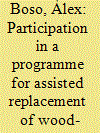|
|
|
Sort Order |
|
|
|
Items / Page
|
|
|
|
|
|
|
| Srl | Item |
| 1 |
ID:
162916


|
|
|
|
|
| Summary/Abstract |
Regional air pollution is strongly impacted by transportation emissions. Policy mechanisms to reduce emissions are required to reach environmental quality goals. Projecting the drivers (e.g., technical, economic, societal, regulatory) that will impact future emissions is challenging, and assessing regional air quality (AQ) is complicated by the need for detailed modeling tools and data inputs to simulate chemistry and transport of pollutants. This work assesses the contribution of emissions from transportation sources to ground-level concentrations of ozone and fine particulate matter via two methods. First, impacts are quantified for three U.S. regions including California using output from an economic optimization model to grow a base year emissions inventory to 2055. Second, impacts are considered for California using state-level projections with an updated emissions inventory and modeling suite in 2035. For both, advanced AQ models are used, showing that the impacts of light duty vehicles are moderate, reflecting shifts to more efficient and lower emitting technologies. In contrast, heavy duty vehicles, ships, and off-road equipment are associated with important ozone and PM2.5 burdens. Emissions from petroleum fuel production and distribution activities also have notable impacts on ozone and PM2.5. These transportation sub-sectors should be the focus of future emissions reduction policies.
|
|
|
|
|
|
|
|
|
|
|
|
|
|
|
|
| 2 |
ID:
183612


|
|
|
|
|
| Summary/Abstract |
In this paper, we study the policies that regulated the energy mix in the Polish residential sector between 1990 and 2021. We apply a qualitative assessment of policies and difference-in-differences to evaluate the effects of particular regulations. We find that policymakers in Poland did not identify households as stakeholders in their strategies since starting the energy transformation back in the 1990s until the early 2020s. We demonstrate that the government policies failed to stimulate efficient decarbonisation of the residential sector and did not address such issues as energy poverty and air pollution, while the coal consumption rates by Polish households remained the highest in the European Union. The situation has started to change since 2017 when the first regions in Poland introduced anti-smog regulations, which have had a minor, yet positive effect on air quality and the decrease in the number of coal stoves. Furthermore, “Clean air” and “My electricity” programmes were introduced in 2018 and 2019, which provided subsidies for investments in clean heating technologies, and small-scale photovoltaics. These support instruments have yielded relatively positive results. Finally, the Polish energy policy of 2021 identified decarbonisation in the residential sector, reducing energy poverty and improving air quality as key priorities.
|
|
|
|
|
|
|
|
|
|
|
|
|
|
|
|
| 3 |
ID:
171393


|
|
|
|
|
| Summary/Abstract |
Evidence from south-central Chile shows that the concentration limits for PM10 and PM2.5, defined by both the World Health Organization and national standards, are systematically exceeded, affecting approximately 10 million people. Among the sources of this pollution, firewood use accounts for the largest share. This study assesses whether consumers value environmental, social, and legal attributes associated with the firewood certification programs. We used a discrete choice model based on a sample of 500 households. According to our results, the price premium for certified firewood is about 10% in the most likely scenario, with those attributes closely related to private benefits having a higher value, compared to those of social benefits. We identify significant heterogeneity among respondents belonging to two different consumer classes: 1) those who are less price sensitive and are willing to pay for attributes related to certification; 2) those who are sensitive to prices and are not willing to pay for attributes related to certification. Since the second class includes about 46% of the sample, the implementation of certification programs could be jeopardized. Therefore, knowing this information helps us determine whether a certification system can foster the firewood industry transition to a more sustainable model.
|
|
|
|
|
|
|
|
|
|
|
|
|
|
|
|
| 4 |
ID:
150389


|
|
|
|
|
| Summary/Abstract |
South Korea has recently chosen coal as the major energy source for the future national electricity power supply, mainly due to economic reasons. This has raised concerns about national air quality, considering the serious air pollution associated with the long-range transport of Chinese air pollutants. In the present study, we simulated air pollution levels for 2027 considering the changes in electricity power plants of South Korea proposed by the sixth Basic Plan for Long-Term Electricity Supply and Demand (6th BPE, 2013–2027). Compared to the emissions in 2010, the emissions of CO, NOx, SOx, and PM10 from electricity supply in the Incheon, Gyunggi, Gangwon, Chungnam, and Gyeongnam regions will increase by 20–50% in 2027. The resulting number of days on which pollution levels exceeded the national air quality standards for O3 and PM10 will increase by fewer than 6 days in all regions, which seems to be a minor increase. However, that of NO2 over the Seoul metropolitan area (SMA, including Incheon, part of Gyunggi, and Seoul) showed a marked increase of more than 21 days. Therefore, an impact from secondary air pollution, such as acid rain and PM2.5 formation, can be expected, although this requires quantification.
|
|
|
|
|
|
|
|
|
|
|
|
|
|
|
|
| 5 |
ID:
163552


|
|
|
|
|
| Summary/Abstract |
Discussions about “peak oil demand” tend to focus on passenger vehicles, often from a US and European perspective. These discussions often ignore other markets, such as marine transport, which collectively would also need to show a reduction in demand if oil consumption were to reach an inflection point. We explore the outlook for marine bunkers, a niche market that accounts, depending on estimates, for up to 7% of the demand barrel. We focus on the possible impact of new environmental restrictions that aim to drastically reduce sulfur oxide (SOx) emissions from ships as of January 2020, placing them against the background of past innovations that have been reshaping ships’ fuel consumption patterns and assessing their likely impact on future innovation in the sector. We conclude that the rules might paradoxically end up slowing down what might have otherwise been a more rapid transition of the shipping market away from traditional bunker fuels. The rules will, however, adversely affect simple refineries and producers of heavy, sour crude oil grades, whose prices are sometimes indexed to that of high sulfur fuel oil (HSFO).
|
|
|
|
|
|
|
|
|
|
|
|
|
|
|
|
| 6 |
ID:
166514


|
|
|
|
|
| Summary/Abstract |
Temuco and Padre Las Casas are two of the most polluted cities in southern Chile; around 90% of the particulate matter emissions are produced by wood-burning stoves used for domestic heating and cooking. Surveys were collected from 489 residents to examine differences between applicants and non-applicants to a programme to replace wood-burning stoves with pellet stoves. Results show that participants who applied to the programme are, on average, older than non-applicants, are more likely to have a respiratory impairment, tend to evaluate indoor air quality worse than non-applicants and tend to perceive the health effects of air pollution as more severe. The findings also suggest that motivation to improve air quality is a key aspect for understanding the adoption of pellet stoves when the requirement for initial investment is removed. Practical implications relating to the role of sociodemographic and psychological factors in the decision to replace heating systems are discussed to support the design of more effective interventions to mitigate wood smoke pollution.
|
|
|
|
|
|
|
|
|
|
|
|
|
|
|
|
| 7 |
ID:
181797


|
|
|
|
|
| Summary/Abstract |
The implementation of China’s clean energy deployment policies has produced considerable benefits of ambient air quality improvement as well as the corresponding reduction of disease burden. However, few studies have focused on their quantification. In this study, we developed an integrated evaluation framework to assess the benefit of reduced disease burden resulting from the air quality improvement after the deployment of clean energy in Hebei Province, China. It was found that the pollutant emissions could be reduced by 18–45% and 33–66% under the General Policy (GP) and Strengthen Policy (SP) scenarios in 2030. The household sector has the largest reduction potential for all pollutant emissions, followed by the power sector with a considerable reduction effect on SO2 and NOx. The annual mean PM2.5 concentration was estimated to decrease from 52 μg m−3 under the Business as Usual (BAU) scenario to 40 μg m−3 under the SP scenario in 2030. Consequently, the disease burden due to air pollution would be reduced by 7499 and 12260 cases, respectively, under the GP and SP scenarios in 2030. Our study confirmed the effectiveness of clean energy deployment policies, and could provide scientific support and significant information to policymakers.
|
|
|
|
|
|
|
|
|
|
|
|
|
|
|
|
| 8 |
ID:
109403


|
|
|
|
|
| Publication |
2011.
|
| Summary/Abstract |
This study quantifies the costs and benefits of Integrated Environmental Strategies (IES) of reducing air pollutants and greenhouse gas (GHG) emissions at a minimal cost in the Seoul Metropolitan Area (SMPA) for the year 2014 and compares with current air quality management plans and greenhouse gas (GHG) mitigation plans. The results estimated health benefits from prevention of premature mortality under the IES scenario as 14 trillion Korean won (won) and associated cost as -3.6 trillion won, yielding total benefit, difference of benefits and costs, of 18 trillion won. With the inclusion of benefits from GHG reductions, the total benefits result in 147 trillion won. The difference of human health benefits and costs of air quality management plan and GHG reduction strategies result in 14 trillion won and 8 trillion won, respectively. The research shows that benefits of integrating air quality management and GHG reduction measures are greater than those obtained by air quality management and GHG reduction measures individually.
|
|
|
|
|
|
|
|
|
|
|
|
|
|
|
|
| 9 |
ID:
186952


|
|
|
|
|
| Summary/Abstract |
This paper constructs a fixed effect model to study the impact of turnover of local government officials on local air quality, and the mechanism through which this effect takes place, using data from 282 prefecture-level cities in China from 2015 to 2019. This research shows that turnover of local government officials led to a decline in local air quality, mainly due to a “responsibility gap period.” It also found that the heterogeneity of officials and the difference in the implementation of political initiatives by cities affected the length of the “responsibility gap period” – the shorter it was, the lower the air pollution was during official turnover. Air pollution in China is still severe and the Chinese central government should therefore further reform the turnover system to improve local air quality during the turnover of key local officials by shortening the “responsibility gap period.”
|
|
|
|
|
|
|
|
|
|
|
|
|
|
|
|
|
|
|
|
|